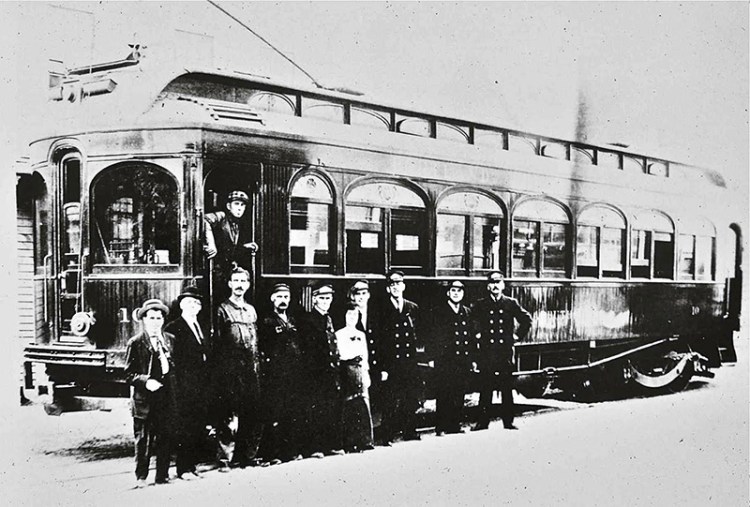June 29, 1914: The Arbutus, an electric car on the Portland-Lewiston Interurban trolley, makes the system’s initial run from Lewiston to Portland with inspecting railroad commissioners on board.

The system starts with six cars and eventually expands to nine. Shortly after it starts operation, the Interurban becomes an electric railroad subsidiary of the Androscoggin Electric Company. The service offers runs every two hours between Monument Square in Portland and Union Square in Lewiston, makes 11 stops. The fare is 75 cents. The running time is 90 minutes. The last train leaves Portland at 10 p.m. In short order, more cars are added and service is offered hourly. Eventually, an express run making stops only in West Falmouth, Gray, New Gloucester, Upper Gloucester and Danville is added, as is a run making additional local stops.
The increasing popularity of cars and construction of a modern highway between the two cities in the late 1920s reduces demand for the Interurban, and the line goes out of service on June 29, 1933 – 19 years to the day after its opening.
June 29, 1941: The 40-foot cabin cruiser Don, loaded with picnic-bound passengers from the towns of Rumford and Mexico, heads from Harpswell to Monhegan Island.
The motorboat stops briefly at West Point, near Phippsburg’s Cape Small, before beginning its three-hour crossing to the island at 10 a.m. Then it disappears.
A search reveals that the worst maritime catastrophe in 16 years has killed everyone aboard. Two of the dead are found floating off Bailey Island. A total of fourteen bodies are recovered by mid-July. Some are wearing wristwatches, which are stopped at times ranging from 11:35 to 11:43. None of the bodies is wearing a life jacket, even though the vessel was equipped with 40 of them, suggesting that the emergency developed quickly.

The sinking of the cabin cruiser The Don was one of the tragedies of 1941. An overloaded boat set out for Monhegan Island with 34 people aboard. It was last seen by a keeper of Sequin light. The boat disappeared and there were no survivors. Edward Roach, left, and Simon Anderson stand on the Bailey Island Wharf, both fathers who lost children in the sinking of The Don. The bodies of their children had not yet been recovered. Portland Press Herald photo courtesy Portland Public Library Special Collections and Archives
The Don’s wheelhouse and some other wreckage float ashore. A board of inquiry concludes that a groundswell caused the boat to capsize because of instability and the weight of the passengers. Other observers theorize that the boat exploded, noting that it had a history of gasoline tank repairs, and that it was it was carrying 150 gallons of gasoline on the Monhegan trip.
A state official says the vessel had sunk three times before and was raised again each time.
Presented by:

Joseph Owen is an author, retired newspaper editor and board member of the Kennebec Historical Society. Owen’s book, “This Day in Maine,” can be ordered at islandportpress.com. To get a signed copy use promo code signedbyjoe at checkout. Joe can be contacted at: jowen@mainetoday.com.
Comments are not available on this story.
Send questions/comments to the editors.


